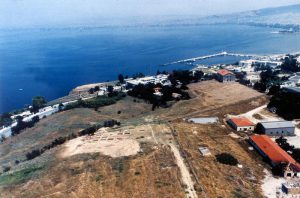Karabournaki or Little Karabournou is located in the North Aegean, on the edge of the promontory in the center of the Thermaic Gulf in the area of modern Thessaloniki (pic.1). Behind the promontory stands a low mound (toumba) (24 m. high), which was artificially created through the continuous habitation of the area. Part of the mount is now lost under the sea (pic.2, pic.3).

The archaeological site preserves the remains of an ancient settlement, including a harbor and the cemeteries. The revealed ancient houses indicate that the primary section of the settlement was placed on the top of the mound (pic.4, pic.5, pic.6) with its cemeteries extended to the area surrounding the foot of the hill. The Thermaic Gulf reaches the lower part of the mound and remains of the ancient harbor (pic.7) are still distinguishable under the water in the zone of the modern Kyverneion (Palataki). Even though no inscription with the name of the ancient city has been found yet, it is probable that the site was part of the ancient city of Therma, the most important settlement in the Thermaic Gulf before the establishment of Thessaloniki in the late 4th c. B.C. Therma was built “komidon”, meaning that was consisted from small settlements located in a small distance one to another. Due to its harbor, Karabournaki appears to be one of the most important parts of Therma during the Archaic and Classical times.
